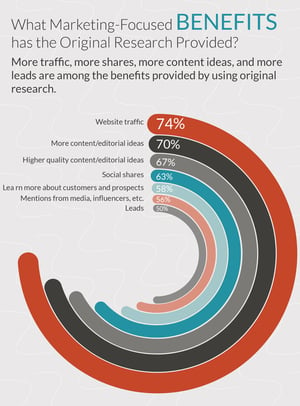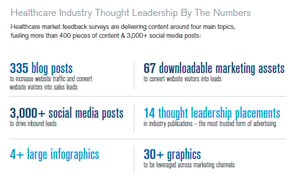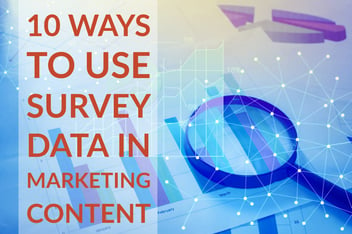Lessons From 15 Years: Use Surveys & Original Research To Fuel Content
When you are trying to cut through the clutter of an exponentially expanding amount of online content, it has to be great (as I talked about in my last lesson). One way of making your content great is to base it on original research.
In fact, marketers told Mantis Research that some of the benefits of using original research include: 
-
Increased website traffic
-
More content ideas
-
Higher quality content ideas
-
Social shares
In fact, 56 percent of those surveyed said the use of original research either met or exceeded all or most of their expectations, as they used original research in blog posts, infographics, videos, press releases and other marketing and PR content. (See even more results in this post: How Marketers Use Original Research to Fuel Content.)
Those survey results don’t surprise me at all. Original research, especially in the form of marketing surveys, has been a foundation for most of JONES’s best performing campaigns for clients throughout our 15-year history. In today’s lesson, I’ll walk you through the steps of how to plan, create and implement marketing surveys that fuel great content.
____________________________________________________________________
This post is one in a 15-part series looking back at the lessons learned in my 15 years as founder and owner of JONES Marketing & PR. Find two of the most recent posts in the series here:
-
Lessons From 15 Years: Telecom Industry Marketing Means Staying On Top Of Everchanging Trends
-
Lessons From 15 Years: Successful Marketing Relies On Great Content
____________________________________________________________________
Marketing Lesson #14
Marketing surveys are one of the best sources for original data and stories that fuel great content.
One of the criteria I listed in the last lesson as being a hallmark of great content is that it is unique. When carefully crafted, marketing surveys will nearly always deliver content that is unique, because the data gathered through your survey will be something that simply isn’t available anywhere else.
But before you rush off and create a quick survey thinking you’re on the road to a new campaign, let’s step back a bit. The best methodology for utilizing marketing surveys that fuel content may not follow the order you think. Below are six key steps we take at JONES to ensure we design surveys that deliver unique content that can fuel hundreds of pieces of content for our clients, with a focus on telling stories that resonate with their prospects and customers.
Using original research and market surveys to fuel great content
1. Start by planning the content strategy you want the surveys to feed.
Before you start writing questions and determining how you will solicit responses, the first step is to know how you will use your survey results.
This means looking at your current integrated PR and marketing strategy, and each of the channels you use, to determine which ones you will target with content from the surveys. How much content do you want to generate?
My tip: Think big. Don’t limit yourself to a downloadable report and a single blog post. A well-planned marketing survey can easily fuel 100+ pieces of marketing content spread over multiple campaigns. (Doubtful? This checklist shows you how: Maximizing Marketing Surveys—How to Turn 1 Survey Into 100+ Content Concepts.) 
At JONES, we have led more than 100 market research surveys for companies such as West's (Intrado and TeleVox), PayNearMe, Luma Health, Total Brain, LiveOffice, Cornerstone OnDemand, ACI Worldwide, Wallop! and Bellevue University.
We always begin with a content strategy that outlines marketing campaigns including reports, blog posts, social media content, infographics, bylined articles for industry media and videos.
For more than a decade, West relied on JONES to turn surveys into marketing and PR content. See how a completed campaign, encompassing all of these elements, comes together here: West Puts Together Complete Marketing Content Package.
When you know from the beginning how you want to use the results, you can create better surveys. Just as with goal setting, you have to know where you are going, and have a map of how to get there.
2. Identify the key stories you want to tell.
Don’t start with the survey questions. If you want your survey to be the basis for marketing and PR content, you need to start with the marketing campaigns you plan to execute. That means you need to have a solid grasp on the stories you plan to tell during the next 12-18 months.
For example, for West, we identified the 12-month marketing campaign calendar. Then, we brainstormed with the product and sales teams, to determine the stories we wanted to tell and how West’s products can be used to solve various customer problems. And, then, we designed survey questions to support those campaigns.
So, take the time to detail the stories you want the survey data to help you tell. Think about the many different forms those stories can take and the data you will need to tell them.
You will also want to maximize the efficiency of your survey and gather enough information in a single survey to fuel several different storylines. When we create surveys for clients, we plan to cover multiple topics, providing plenty of fodder for several marketing and content campaigns.
In working with Bellevue University to develop surveys designed to fuel content promoting the institution’s online degree program, we knew from the University’s own experience and anecdotal stories from both students and employers that adult learners have unique challenges that most recent high school grads don’t face. And we knew that employers were seeking skills that that recent college graduates were lacking.
We outlined stories addressing both groups — adult learners and employers — that we wanted the surveys to help us tell.
Those story outlines, along with an understanding of the types of content and channels we planned to employ through our marketing and PR strategy, set the stage for step 3.
3. Craft survey questions that unveil your stories and will keep respondents engaged.
Once you know what topics you will cover and the stories you want to tell, you’ll need to carefully consider the types of questions that will provide the most useful results for each topic.
Questions may be open ended, rating scales, multiple choice, ranking, or a choice between two options. The types of questions, and how you choose to combine them, will depend on the types of data you need, the depths of information you need and the time your respondents have available.
This article from SurveyMonkey does a great job of explaining the pros and cons of different question types.
You will also need to put thought into what questions are needed for gathering basic demographic information and for screening responses, if needed, to ensure they fall within the specific parameters of your research (such as having a specific job title or living in a specific geographic area).
In writing the survey, you should also keep in mind the overall length of the survey, the length of time it takes to respond, and barriers that may prevent respondents from completing the survey. What may be a tolerable length for one survey topic and cohort, may not be for another.
For example, when we were developing a customer survey for West Safety Services, we broke it into two different surveys to keep the length of the survey effective, while gathering the data we needed to tell a number of stories around location-based technology. The surveys were designed to be executed two months apart to reduce fatigue while capturing qualitative data to fuel the company’s 12-month marketing plan.
Not only do you need to craft survey questions that keep your respondents engaged, you also need to begin planning early so you can build-in time to execute your survey(s).
4. Execute survey through chosen platform.
The actual execution of a survey can be done through a number of different platforms. While there may still be some instances in which paper “fill in the bubble/blank” surveys or telephone surveys could be used, most will be completed online through a digital platform. Platform options for a digital survey range from a research firm’s proprietary software to commercially available services such as SurveyMonkey or AYTM.
Working with a specialized research firm with its own software has advantages — access to experts with experience in both survey execution and data analysis — but lower-cost options can also be effective, especially if you partner with a full-service marketing firm with experience taking the survey from initial strategy through content creation and campaign launch.
Also carefully consider how you will promote and distribute the survey. Do you have an appropriate contact list for the topics you are covering, or do you need to find a source for a distribution list? Are you using a limited list of respondents, or opening it up to the world and promoting widely through channels such as social media? What time frame will the survey be open, and how many respondents will you need to generate data that is useful and reliable?
Many of these questions may be best answered with input from experienced researchers or a partner agency.
Check out these five questions you should ask when choosing a survey partner.
5. Export data and analyze.
Survey results should be compiled into easily-readable spreadsheets with full results, in addition to teasing out specific stats that are especially relevant for the content and storylines planned for the marketing and PR content the survey was designed to fuel. Ensure that if you work with a partner agency that your agreement includes that you will receive the complete data set, not just a page or two of highlights.
Once the results have been tallied, reviewed and analyzed, your team may want to conduct additional research with outside sources to add additional context to the results before entering the next step of the process.
This is one step where it becomes obvious that marketing and PR are not strictly creative endeavors. Analysis, math and an understanding of statistics is essential. While we may often talk about marketing analysis strictly in terms of measuring success and calculating ROI, being able to accurately analyze the results of a survey to draw accurate conclusions and find compelling stories is just as important.
While the stories you want to tell drive how your survey is written, the content created from the survey is driven by the data — including when the story is different from what you originally expected.
Don’t stop with just the stories you set out to tell. Chances are good there are many more stories to be found in your survey data if you take the time to look.
Don’t accept a simple summary of the highlights if you work with a research firm. Review the data line by line yourself to avoid leaving useful stories on the cutting room floor — every question has a story to tell. Listen to what Julie Steele, Director of Marketing at Manifold, an artificial intelligence engineering services firm, and former Director of Communications at Silicon Valley Data Science, has to say about telling stories with data at a 2013 TED Talk.
The ability to read and analyze data is one of the most-often overlooked skills a marketer (or marketing agency) needs to have to make sense of the numbers involved, whether survey data or measurement and metrics of your marketing tactics. (This infographic covers other skills you need from your in-house marketing team and any partner agencies.)
From a single survey, JONES helped West develop more than 400 pieces of content (plus another 3,000+ social media posts). Included in that content were 14 different thought leadership articles placed in industry publications touching on a wide range of topics, plus related blog posts for West’s website. 
From that one survey, a sampling of article headlines included:
-
Five Frustrations Patients Face When Calling Healthcare Providers
-
Making Sure Patients Know and Understand Health Numbers is Critical to Driving Better Health Outcomes
-
Patient Phone Calls Are Down, Other Communication Options on the Rise
-
Improving Patient Survey Response Rates
-
How Patient Surveys Can Prop Up Population Health Initiatives
-
Patient-Provider Texting Is Poised For Growth
-
Patients In Pain Go To the Hospital When Other Care Options May Be Faster, More Effective and Less Costly
-
Consumers Say The Healthcare Industry Keeps Them Waiting
This is just a sampling of the different storylines West and JONES targeted, with data from the surveys to back up messaging aimed at addressing multiple challenges faced by healthcare providers and institutions.
6. Refine content strategy and create complete campaigns.
With all of your data in hand, it is time to go back to that original marketing and PR strategy that outlined the channels and specific content pieces you wanted to fuel with the survey. At this point, a good way to start is to write abstracts for each story you intend to tell — perhaps each story is a separate campaign, scheduled monthly over the next year. Those abstracts can then be used as the basis for pitching bylined articles to industry media, for outlining full reports, for sketching out a schedule of blog posts that break the reports down into smaller segments, and for videos and infographics that will supplement all of the other content in the campaign.
Abstracts may vary in length and detail, but as you begin your content campaign planning, you can start with a simple working headline and two to three sentences about the topic. If you are basing the campaign on information from original research or surveys, include the key data points or statistics driving the campaign messaging.
Using this method, a single concept — outlined in a simple two-sentence abstract — can be the genesis for a complete inbound marketing campaign, from start to finish, from awareness through lead nurturing to sales enablement. When approached in this way, public relations, marketing and sales can work together to provide a united message and maximize the ROI from a single survey.
You’ll find more details on expanding the abstract into each of these different campaign elements here: Marketing Content Abstracts — A Complete Campaign.
Strategic use of marketing surveys has led to some of the most successful marketing and PR campaigns we have developed for clients, in both B2C and B2B markets. Here are just a couple more posts highlighting how we’ve used survey data to fuel great content:
-
Client Success: Turning Higher Education Research Into Nationwide News Coverage
-
Client Success: West Turns Original Research Into Lead Generation
You may also want to learn more by downloading our survey resources:
Of course, you can also schedule a no-obligation consultation with me< https://www.jonespr.net/meetings/kristin19> to learn more about how JONES approaches surveys as an integral part of an overall marketing and public relations strategy.
And keep reading! I have just one more official lesson left to share in this series of 15 Lessons From 15 Years. But I will continue as always to share helpful posts every week even once the series has ended.
-1.png?width=1652&height=294&name=Jones(RGB)-1.png)








.png?width=352&name=How%20Marketers%20Use%20Original%20Research%20To%20Fuel%20Content%20(infographic).png)



